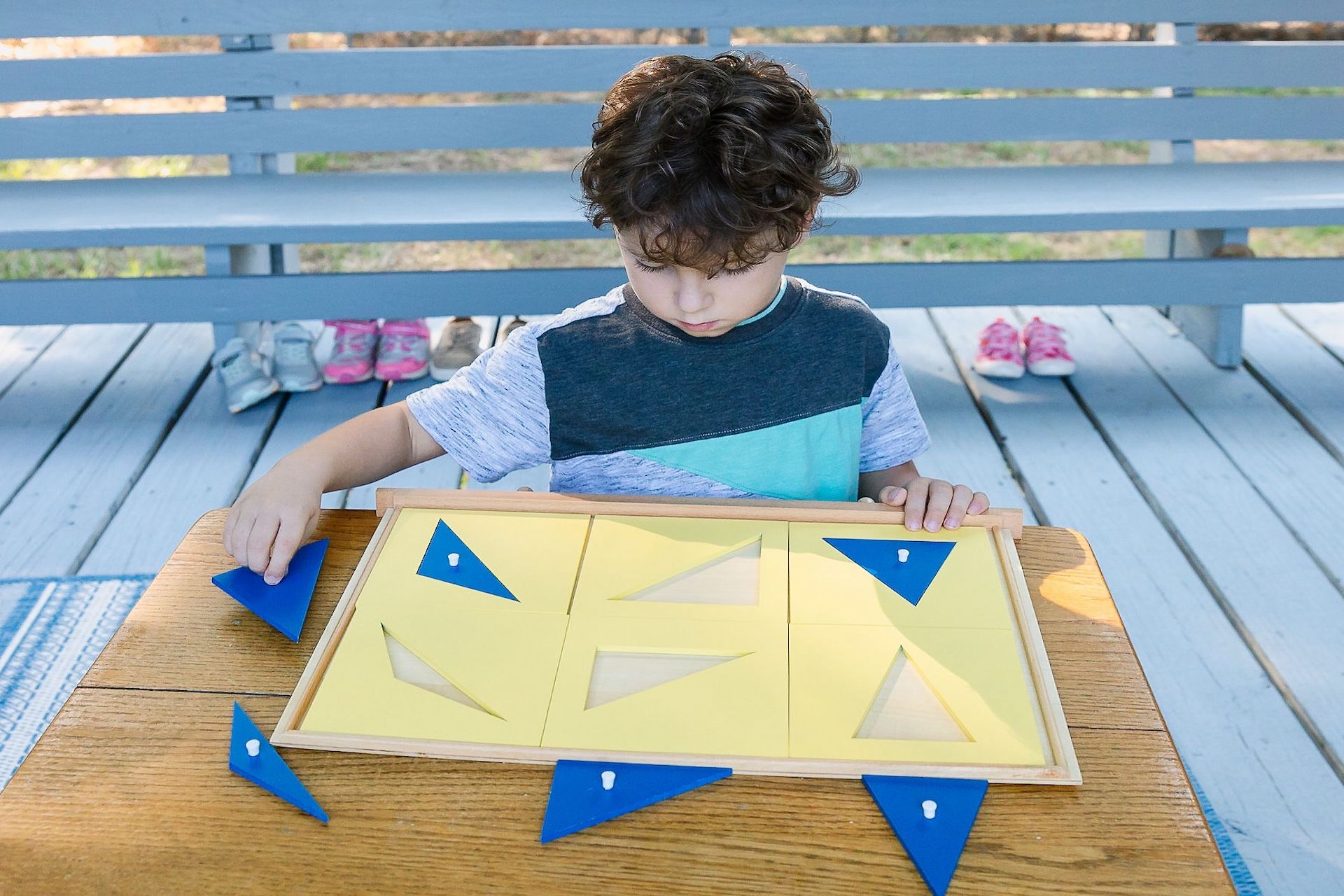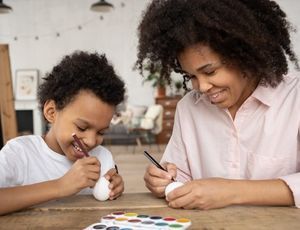Materials Spotlight: The Geometry Cabinet

Nestled on a shelf in Montessori primary (MSL’s Early Childhood) classrooms you’ll find a small wooden cabinet with six to seven slim drawers. It may not look like much from the outside. Even when you slide out one of the drawers, you’ll just see six wooden square divisions each with a wooden inset with a small knob in the center. As you continue to pull out the different drawers, you’ll discover that each wooden inset is a series of geometric shapes: circles that vary in diameter, rectangles with the same height but varying in width up to the square, different triangles, regular polygons, quadrilaterals, and curved figures.
This is the Geometry Cabinet, an important and well-used material in Montessori primary (and elementary) classrooms. With a multitude of uses, this material serves to help children not only enhance their visual and muscular memory, it also provides a foundation for advanced geometry work as well as preparing children’s hands for writing.
The Foundation for Geometry
First and foremost, the geometry cabinet introduces plane geometry. Often, you’ll see a demonstration tray on the top of the cabinet. This tray contains insets of the equilateral triangle, square, and circle. These three shapes form a foundation in geometry: the circle calculates angles, the triangle constructs, and the square measures area.
Another fun way to think about these three shapes is in terms of polygons. The equilateral triangle is the polygon with the least possible number of sides. The circle can be thought of as a polygon with infinite sides. The square represents the rest of the polygons. Of course, this is something Montessori children get to explore in their elementary years. In the primary classroom, we use this demonstration tray to introduce how to use the geometry cabinet trays and insets, as well as to provide children with the first impression of the three fundamental shapes in geometry.
A Tactile Experience
One of the first things we do with the geometry cabinet is demonstrate how to use the knob to pick up the shape with the non-dominant hand and then trace the whole perimeter of the shape with the index and middle fingertips of the dominant hand. We also show how to trace the outline of the aperture that the shape fits into. This careful, meditative action is designed to both give children a tactile impression of the shape and to help them develop the fine motor control necessary for writing.
Once children have this experience with a few shapes, they move on to tracing and matching the shapes from a whole drawer and then even mixing up the shapes from multiple drawers to trace and match into their aperture. When children get good at this process, we introduce taking away the visual sense by wearing a blindfold!
From Concrete Objects to Abstract Symbols
We also introduce sets of cards for each geometric shape. In the first set, the figure is filled in completely. In the second set, each figure has a one-centimeter wide outline. In the third set, each figure has a one-millimeter wide outline. Children select an inset shape and go through the stack of the first set of cards until they find the one that matches the shape. Then they place the inset exactly onto its matching card.
By placing the inset shapes onto the cards with thick to thin outlines, children are learning how an abstract symbol can represent a concrete object. This is preparation for reading! If children can recognize and distinguish between a trapezoid and a parallelogram, they will be more likely to be able to distinguish two other shapes like a cursive b and a cursive z. When children have a lot of experience recognizing shapes, they will be more able to recognize the shapes they encounter in letters because symbols are shapes defined by lines. Think about the progression of abstraction from a filled-in trapezoid, to the outline of trapezoid, to the letter A.
Rich Language
As children are working with these shapes, we also revisit the material to introduce vocabulary. Even the youngest children are learning the names of quadrilaterals (rectangle, square, rhombus, parallelogram, isosceles trapezoid, right-angled trapezoid), curved figures (circle, oval, ellipse, quatrefoil), triangles (equilateral triangle, right-angled isosceles triangle, acute-angled isosceles triangle, obtuse-angled isosceles triangle, right-angled scalene triangle, acute-angled scalene triangle, obtuse-angled scalene triangle), and polygons (pentagon, hexagon, heptagon, octagon, nonagon, decagon). Because young children absorb this language effortlessly, we offer them the exact names. Rather than just “triangle,” Montessori children learn how to differential triangles based on their angles and sides. They can just as easily name an acute-angled scalene triangle as they can an ellipse.
Memory Games
We also use the Geometry Cabinet to play a series of sensorial games that help children perfect their perceptions and make their mental classifications conscious.
In the first memory game, the geometry shapes and their apertures are mixed up between two locations in the room, far enough apart to allow more time for children to hold the memory of the shape as they move through various potential distractions to find the match. The second game is a little harder because the shapes are placed in scattered locations around the room. When children go to find a specific shape, they must retain the impression in their memory for a much longer time and not be distracted by the other images they are receiving. In this process, children are exercising their skills of memory and recognition.
The third memory game is one in which children try to find an object in the room that has the exact match of the shape. This experience allows children to move from working with the geometric qualities in their isolated form in the material to helping discover the qualities of the shapes in the world around them.
The final game is a group experience with one of the trays containing one type of shape that changes in dimension, such as the six circles with increasing diameter, or the six rectangles with increasing width. In this game, the children work together to show the sequence of gradation in the shape. In a more difficult version of this game, children take their piece and experience it (look at it, touch/feel it, etc.) and then put the shape behind their backs. They then try to lay out the pieces in the correct order of size without seeing each other’s shapes!
Multiple Benefits
While the main purpose of the Geometry Cabinet is to help children develop the visual discrimination of shapes (an important skill used in learning and especially reading), there are so many other benefits. The activity of tracing their fingers along the edges of the shapes and frames helps prepare children for using a pencil to make the shapes that form letters. Grasping the knobs helps them refine their pincer grasp. They learn important vocabulary and also increase their concentration and fine motor control.
A simple material with so many benefits, the Geometry Cabinet is a material worth coming to see. We invite you to visit to experience first-hand how children interact with this foundational geometry material. Schedule a tour today!






